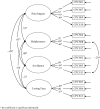Development of the Chronic Pain Cognition Scale: A Culture-Sensitive Pain Measurement in Chinese
- PMID: 37701561
- PMCID: PMC10493149
- DOI: 10.2147/JPR.S422197
Development of the Chronic Pain Cognition Scale: A Culture-Sensitive Pain Measurement in Chinese
Abstract
Purpose: People with pain problems are highly vulnerable to cultural disparities, and it is imperative to reduce these inequalities. This cross-sectional study aimed to develop a culturally sensitive Chronic Pain Cognition Scale (CPCS) for Chinese-/Chinese dialect-speaking populations and investigate its psychometric properties.
Patients and methods: Adult patients with chronic low back pain or chronic neck pain who visited pain clinics at a medical center in northern Taiwan were enrolled. Participants completed the demographic, intensity of pain, and two other related sensations, "Sng ()" and "Ma ()", often reported in Chinese-speaking populations, CPCS, Chronic Pain Acceptance Questionnaire-8, and Pain Self-Efficacy Questionnaire.
Results: 200 patients were included. Patients' mean age was 64.84 ± 14.33, 126 (63.0%) were female, and 83 (41.5%) had 13+ years of education. The average duration of pain was 77.25 ± 97.46 months, the intensity of pain was 6.04 ± 2.50, Ma was 3.43 ± 3.24, and Sng was 4.54 ± 3.14. The CPCS comprised four factors: pain impact (how pain impact one's life), losing face (how one being disrespected due to pain), helplessness, and avoidance, with good structural validity and adequate reliability (Cronbach α, 0.60-0.81) and satisfactory criterion-related validity. Moreover, losing face, an essential concept in Chinese relationalism, was significantly related to pain, Sng, and Ma (r = 0.19, 0.15 and 0.16), but not to pain acceptance or self-efficacy, indicating a culturally specific element in pain measurement.
Conclusion: The CPCS has good psychometric properties and is suitable for evaluating chronic pain in the clinical setting, and might be generalizable to other Chinese-/Chinese dialect-speaking populations.
Keywords: avoidance; helplessness; losing face; low back pain; neck pain; pain impact.
© 2023 Wu et al.
Conflict of interest statement
The authors report no conflicts of interest in this work.
Figures
References
-
- Merskey HE. Classification of chronic pain: descriptions of chronic pain syndromes and definitions of pain terms. PAIN. 1986;3(Suppl.):216–221. - PubMed
-
- International Association for the Study of Pain (IASP). IASP Announces Revised Definition of Pain; 2020. Available from: https://www.iasp-pain.org/PublicationsNews/NewsDetail.aspx?ItemNumber=10475. Accessed December 29, 2020.
LinkOut - more resources
Full Text Sources


